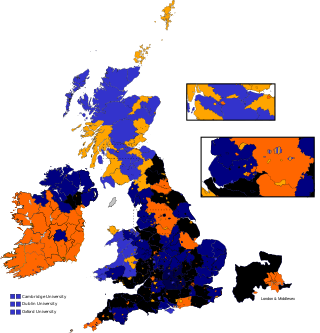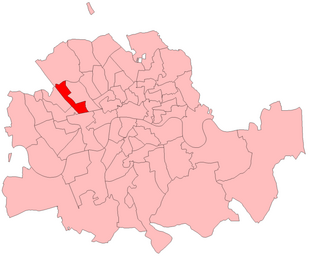History

The constituency was created by the Redistribution of Seats Act 1885 for the 1885 general election, and abolished for the 1918 general election.
| St Pancras East | |
|---|---|
| Former borough constituency for the House of Commons | |
| 1885–1918 | |
| Seats | one |
| Created from | Marylebone |
St Pancras East was a parliamentary constituency in the St Pancras district of North London. It returned one Member of Parliament (MP) to the House of Commons of the Parliament of the United Kingdom.

The constituency was created by the Redistribution of Seats Act 1885 for the 1885 general election, and abolished for the 1918 general election.
| Election | Member | Party | |
|---|---|---|---|
| 1885 | Thomas Gibb | Liberal | |
| 1886 | Robert Webster | Conservative | |
| 1899 | Sir Thomas Wrightson | Conservative | |
| 1906 | Hugh Lea | Liberal | |
| 1910 (Jan) | Joseph Martin | Liberal | |
| 1918 change | Labour | ||
| 1918 | constituency abolished | ||
| Party | Candidate | Votes | % | ±% | |
|---|---|---|---|---|---|
| Liberal | Thomas Gibb | 2,416 | 52.7 | ||
| Conservative | Robert Grant Webster [4] | 2,170 | 47.3 | ||
| Majority | 246 | 5.4 | |||
| Turnout | 4,586 | 77.6 | |||
| Registered electors | 5,913 | ||||
| Liberal win (new seat) | |||||
| Party | Candidate | Votes | % | ±% | |
|---|---|---|---|---|---|
| Conservative | Robert Grant Webster | 2,327 | 56.0 | +8.7 | |
| Liberal | Thomas Gibb | 1,826 | 44.0 | −8.7 | |
| Majority | 501 | 12.0 | N/A | ||
| Turnout | 4,153 | 70.2 | −7.4 | ||
| Registered electors | 5,913 | ||||
| Conservative gain from Liberal | Swing | +8.7 | |||
| Party | Candidate | Votes | % | ±% | |
|---|---|---|---|---|---|
| Conservative | Robert Grant Webster | 2,621 | 54.6 | −1.4 | |
| Liberal | Thomas Gibb | 2,180 | 45.4 | +1.4 | |
| Majority | 441 | 9.2 | −2.8 | ||
| Turnout | 4,801 | 72.8 | +2.6 | ||
| Registered electors | 6,598 | ||||
| Conservative hold | Swing | −1.4 | |||
| Party | Candidate | Votes | % | ±% | |
|---|---|---|---|---|---|
| Conservative | Robert Grant Webster | 2,612 | 52.9 | −1.7 | |
| Liberal | Benjamin Francis Conn Costelloe | 2,322 | 47.1 | +1.7 | |
| Majority | 290 | 5.8 | −3.4 | ||
| Turnout | 4,934 | 70.6 | −2.2 | ||
| Registered electors | 6,988 | ||||
| Conservative hold | Swing | −1.7 | |||
Webster resigned, causing a by-election.
| Party | Candidate | Votes | % | ±% | |
|---|---|---|---|---|---|
| Conservative | Thomas Wrightson | 2,610 | 51.9 | −1.0 | |
| Liberal | Benjamin Francis Conn Costelloe | 2,423 | 48.1 | +1.0 | |
| Majority | 187 | 3.8 | −2.0 | ||
| Turnout | 5,033 | 70.0 | −0.6 | ||
| Registered electors | 7,191 | ||||
| Conservative hold | Swing | −1.0 | |||
| Party | Candidate | Votes | % | ±% | |
|---|---|---|---|---|---|
| Conservative | Thomas Wrightson | 3,016 | 58.9 | +6.0 | |
| Liberal | John Meir Astbury | 2,106 | 41.1 | −6.0 | |
| Majority | 910 | 17.8 | +12.0 | ||
| Turnout | 5,122 | 70.7 | +0.1 | ||
| Registered electors | 7,248 | ||||
| Conservative hold | Swing | +6.0 | |||

| Party | Candidate | Votes | % | ±% | |
|---|---|---|---|---|---|
| Liberal | Hugh Lea | 4,208 | 64.4 | +23.3 | |
| Conservative | Thomas Wrightson | 2,327 | 35.6 | −23.3 | |
| Majority | 1,881 | 28.8 | N/A | ||
| Turnout | 6,535 | 82.1 | +11.4 | ||
| Registered electors | 7,961 | ||||
| Liberal gain from Conservative | Swing | +23.3 | |||

| Party | Candidate | Votes | % | ±% | |
|---|---|---|---|---|---|
| Lib-Lab | Joseph Martin | 4,276 | 54.4 | −10.0 | |
| Conservative | Walter Preston | 3,586 | 45.6 | +10.0 | |
| Majority | 690 | 8.8 | −20.0 | ||
| Turnout | 7,862 | 82.9 | +0.8 | ||
| Registered electors | 9,487 | ||||
| Lib-Lab hold | Swing | −10.0 | |||
| Party | Candidate | Votes | % | ±% | |
|---|---|---|---|---|---|
| Lib-Lab | Joseph Martin | 3,891 | 56.0 | +1.6 | |
| Conservative | John Hopkins | 3,038 | 43.7 | −1.9 | |
| Suffragist | Herbert Jacobs | 22 | 0.3 | New | |
| Majority | 853 | 12.3 | +3.5 | ||
| Turnout | 6,951 | 73.3 | −9.6 | ||
| Registered electors | 9,487 | ||||
| Lib-Lab hold | Swing | +1.8 | |||
General Election 1914–15:
Another General Election was required to take place before the end of 1915. The political parties had been making preparations for an election to take place and by the July 1914, the following candidates had been selected;
West Fife was a parliamentary constituency represented in the House of Commons of the Parliament of the United Kingdom from 1885 to 1974. Along with East Fife, it was formed by dividing the old Fife constituency.
Birmingham Central is a former parliamentary constituency in the city of Birmingham, England. It returned one Member of Parliament (MP) to the House of Commons of the Parliament of the United Kingdom, elected by the first-past-the-post voting system.
Birmingham North was a parliamentary constituency in the city of Birmingham, England. It returned one Member of Parliament (MP) to the House of Commons of the Parliament of the United Kingdom, elected by the first-past-the-post voting system.

Salford North was a parliamentary constituency in the City of Salford in Greater Manchester from 1885 until 1950. It returned one Member of Parliament (MP) to the House of Commons of the Parliament of the United Kingdom.
Birmingham South was a parliamentary constituency in Birmingham which returned one Member of Parliament (MP) to the House of Commons of the Parliament of the United Kingdom from 1885 until it was abolished for the 1918 general election.
Liverpool East Toxteth was a borough constituency represented in the House of Commons of the Parliament of the United Kingdom. It elected one Member of Parliament (MP) by the first past the post system of election.
Blackpool was a parliamentary constituency centred on the town of Blackpool in Lancashire. It returned one Member of Parliament (MP) to the House of Commons of the Parliament of the United Kingdom.

Rotherhithe was a parliamentary constituency centred on the Rotherhithe district of South London. It returned one Member of Parliament (MP) to the House of Commons of the Parliament of the United Kingdom, elected by the first past the post system.

Harrow was a constituency of the House of Commons of the UK Parliament 1885—1945 in Middlesex, a traditional county; it covered an area forming part of the north-west of today's Greater London. It returned one Member of Parliament (MP).

Camberwell North was a borough constituency located in the Metropolitan Borough of Camberwell, in South London. It returned one Member of Parliament (MP) to the House of Commons of the Parliament of the United Kingdom. The constituency was created for the 1885 general election, and abolished for the 1950 general election.
Islington South was a parliamentary constituency in the Metropolitan Borough of Islington in North London. It returned one Member of Parliament (MP) to the House of Commons of the Parliament of the United Kingdom.

Strand was a parliamentary constituency in the Strand district of the City of Westminster. It returned one Member of Parliament (MP) to the House of Commons of the Parliament of the United Kingdom.
Wolverhampton East was a parliamentary constituency in the town of Wolverhampton in Staffordshire, England. It returned one Member of Parliament (MP) to the House of Commons of the Parliament of the United Kingdom.
Birmingham Bordesley was a borough constituency in the city of Birmingham, which returned one Member of Parliament (MP) to the House of Commons of the Parliament of the United Kingdom. Elections were held using the first-past-the-post voting system.

Radnorshire was created in 1542 as a constituency of the House of Commons of the Parliament of England then of the Parliament of Great Britain from 1707 to 1800 and of the Parliament of the United Kingdom from 1801 to 1918. It elected one knight of the shire (MP) by the first past the post system.

Newington West was a parliamentary constituency in the Newington area of South London. It returned one Member of Parliament (MP) to the House of Commons of the Parliament of the United Kingdom, elected by the first past the post system.

Marylebone West was a borough constituency located in the Metropolitan Borough of St Marylebone, in London. It returned one Member of Parliament (MP) to the House of Commons of the Parliament of the United Kingdom, elected by the first past the post voting system.
St Austell was a parliamentary constituency centred on the town of St Austell in Cornwall. It returned one Member of Parliament (MP) to the House of Commons of the Parliament of the United Kingdom.
St Pancras West was a borough constituency represented in the House of Commons of the Parliament of the United Kingdom. It elected one Member of Parliament (MP) by the first past the post system of election. It was created by the Redistribution of Seats Act 1885 for the 1885 general election and abolished for the 1918 general election.

Richard Leopold Reiss, was a British Liberal Party politician who later joined the Labour Party. He was Director of the Hampstead Garden Suburb Trust Ltd. He was awarded the Order of St Olav of Norway. In 1948 he was awarded the Howard Memorial Medal for outstanding services to town planning.